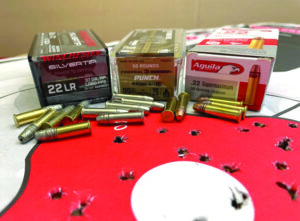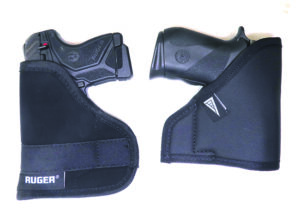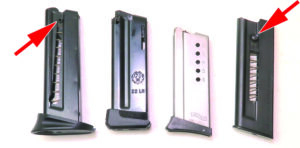In email from Gun Tests reader Jim T. asked for a 22 LR subcompact concealed-carry pistol match up, specifically mentioning the old-school Walther TPH and Ruger LCP II. We winced at the thought because the 22 LR is not an adequate defense round, in our estimation. There are better caliber choices, but 22 LR subcompact pistols are popular and have been since the 1920s. We added two additional subcompacts — a Taurus PT-22 and Beretta 21A Bobcat — to round out the list. Though these mouse guns lack power, they do offer deep concealment and surprise. These are close-quarter guns to be used an arm’s length away, perhaps incapacitating or intimidating your attacker so you can run away to safety or to get a bigger gun.
How We Tested
All of these pistols have short barrels less than 3 inches in length and have tiny, rudimentary sights. Because they are small, they tend to get lost in your hand. There is not a lot to hang onto. Slides are small with minimal serrations, especially in the case of the Taurus and Beretta, and that makes them difficult to operate. The Ruger LCP II was specially designed for ease of slide retraction. Safety levers are also minuscule, as are the magazines, which can be a pain to load.
We accuracy tested at 10 yards, using our range bag as a rest, and found the pea-shooters had good accuracy. We used Thompson Targets Sight-Seer Red targets for accuracy testing. For speed shooting, we performed the Failure Drill — two shots to center of mass, one shot to the head — at 7 yards and found all of these guns performed well and could easily be used to defend yourself. We tested speed using a Thompson Target B27STOP Upper Torso Silhouette Target, which has immobilization zones outlined on the sheet.

Now here’s the “but”: Getting a semi-automatic 22 LR pistol to run consistently is a challenge. There is an embarrassment of 22 LR bullet weights and styles, and some work better than others, depending on the pistol. We would definitely run a lot of 22 LR ammo through these mousey guns to find consistency before we pocketed any of them for defense. With the new guns — Beretta 21A Bobcat, Taurus PT-22, ad Ruger LCP II — we experienced FTF (failures to feed) jams and some FTE (failures to eject) jams, especially in early accuracy testing. The bullet shape makes a big difference on whether the ammo will feed or not. The Winchester Silvertip ammo gave us the most mishaps, and that could be because it uses a larger 37-grain bullet compared to the 30-grain and 29-grain bullets used in the Aguila and Federal ammo, respectively. As we ran ammo through them, they performed more consistently, so keep in mind there is a break-in period for the mouse guns.
We also concealed-carried these pistols in our pocket, using an Elite Survival System Pocket holster PH-1L ($18; EliteSurvival.com), which has a no-slip outside texture that “sticks” to the inside of your pants pocket and allows you to easily draw the pistol. The Ruger LCP II came with a similar style holster, which we thought was added value. All of these mouse guns were easy to carry concealed and simply felt like a wallet in our front pocket.
Test ammo for the mouse guns consisted of two defense loads that on paper make a mouse gun roar: Winchester Silvertips with a 37-grain plated segmenting hollow point bullet and Federal Punch, a 29-grain flat-point solid bullet. We also tested Aguila’s amped-up Supermaximum rounds with a 30-grain copper-plated solid bullet. With 22 LR ammo, you want a bullet to penetrate as much as possible for terminal performance. Heavy clothing and body mass will slow down a 22 LR, which means less penetration. Here are the details.
Gun Tests Grade: A-
$380
We have tested the LCP II in the past and found it to be a well-designed subcompact. The LCP II was the easiest to operate with Ruger’s Lite Rack slide, a feature that makes manipulating the slide easy. It only takes 9 pounds of effort to rack the slide, and the slide has front and rear slide serrations, plus there are cocking tabs at the end of the slide for racking ease. The sights are machined out of the slide, and they are large for a tiny pistol and offer a good sight picture. We felt these sights were easy to acquire. Also, like on a larger-size pistol, the LCP II has a slide stop, and on last round fired, the slide locks back, a feature we appreciate.
| Action | Semi-automatic, blowback, hammer fired |
| Trigger | Single action only |
| Overall Length | 5.2 in. |
| Overall Height | 3.9 in. |
| Maximum Width | 0.8 in. |
| Weight Unloaded | 11.2 oz. |
| Weight Loaded | 12.4 oz. |
| Barrel Length | 2.3 in. |
| Capacity (single stack) | 10+1 |
| Slide | Black, steel |
| Slide Retraction Effort | 9.0 lbs. |
| Frame | Black, polymer |
| Frame Front Strap Height | 1.7 in. |
| Frame Back Strap Height | 2.1 in. |
| Grip | Textured polymer |
| Grip Thickness (max) | 1.9 in. |
| Grip Circumference (max) | 4.7 in. |
| Sights | Integral |
| Trigger Pull Weight | 7.7 lbs. |
| Trigger Span | 2.5 in. |
| Magazines | 1; steel |
| Manual Safety | Blade trigger, thumb, magazine |
| Warranty | None stated |
| Website | Ruger.com |
| Made In | USA |
The manual safety is located near a right-hand-shooter’s firing-hand thumb, but it is difficult to operate with the thumb of your shooting hand. We found it easier to flick forward or back using the thumb of our support hand. When we carried the pistol, we relied on the trigger paddle safety. The manual thumb safety was an obstacle to get the gun online fast and firing.

The LCP II in 22 LR was introduced in 2019, with the LCP II series debuting in 2016 in 380 Auto. The rimfire variants were Ruger’s answer to an easier-to-use, trainer version of the 380 Auto LCP II. All LCP II pistols use Ruger’s Secure Action Fire Control System, which is in essence an SAO trigger with a built-in trigger safety paddle and a secondary sear hammer catch that ensures the pistol is safe to carry. It also has an inertia-style firing pin and a magazine safety. It cannot be fired with the magazine removed from the gun.
The polymer frame has plenty of texture on the grip panels and grip straps for a sure hold. It feels thin and flat in hand like the Beretta, but the Ruger’s magazine floor plate has a built-in finger rest that allows the user to strip out the magazine in the event it sticks. We could only get two fingers on the front grip strap, with the small finger tucked under the magazine.
The magazine ingeniously holds 10 rounds of ammo in such a small amount of space, and it loads like a centerfire magazine. There is no magazine load button to compress the magazine spring. Ruger ships the pistol with a loader, which eases putting rounds in the magazine.

Going hot, we experienced a few FTF jams in the first-stage accuracy testing, and used our support-hand thumb to push the slide home to fire the balky shot. Our best group measured 0.8 inches with Federal Punch. We shot a best group with the Winchester Silvertip that measured 1.2 inches. Not bad for 10 yards and a trigger that broke at 7.7 pounds. In our opinion, the trigger and the sights really helped us shoot the LCP II well. In the Failure Drill, we were very confident with the tiny Ruger. Because the trigger is SAO, the trigger press remained the same for all shots and helped us with the fast first two to the torso and the more precise shot to the head.
Drawing the LCP II from a pocket was smooth, with no snags, because the rear of the slide was smooth and the hammer was enclosed in the slide.
Our Team Said: The LCP II offers ease of use with the Lite Rack feature and has a consistent trigger pull. It also holds 10 rounds of ammo in a small package. In our opinion, this is a good choice for a defensive mouse gun, but we would still shoot a few bricks of 22 ammo through it to properly break it in.
22 LR Range Data
To collect accuracy data, we fired five-shot groups from a bench using a rest. Distance: 10 yards with open sights. We recorded velocities using a ProChrono digital chronograph set 15 feet from the muzzle.| Winchester Silvertip 37-grain Segmented HP | Ruger LCP II | Taurus PT-22 | Beretta 21A Bobcat | Walther TPH |
| Average Velocity | 938 fps | 873 fps | 907 fps | 948 fps |
| Muzzle Energy | 72 ft.-lbs. | 63 ft.-lbs. | 68 ft.-lbs. | 74 ft.-lbs. |
| Smallest Group | 1.20 in. | 1.08 in. | 2.28 in. | 2.15 in. |
| Average Group | 1.61 in. | 1.19 in. | 2.56 in. | 2.48 in. |
| Federal Punch 29-grain Flat SP PO22L1 | Ruger LCP II | Taurus PT-22 | Beretta 21A Bobcat | Walther TPH |
| Average Velocity | 1111 fps | 1027 fps | 1045 fps | 1141 fps |
| Muzzle Energy | 79 ft.-lbs. | 68 ft.-lbs. | 70 ft.-lbs. | 75 ft.-lbs. |
| Smallest Group | 0.80 in. | 1.05 in. | 2.17 in. | 1.35 in. |
| Average Group | 1.50 in. | 1.19 in. | 2.69 in. | 1.60 in. |
| Aguila Supermaximum 30-grain Flat SP | Ruger LCP II | Taurus PT-22 | Beretta 21A Bobcat | Walther TPH |
| Average Velocity | 915 fps | 870 fps | 919 fps | 1065 fps |
| Muzzle Energy | 56 ft.-lbs. | 50 ft.-lbs. | 56 ft.-lbs. | 76 ft.-lbs. |
| Smallest Group | 1.47 in. | 2.88 in. | 1.79 in. | 1.32 in. |
| Average Group | 1.73 in. | 3.16 in. | 2.08 in. | 1.42 in. |


























